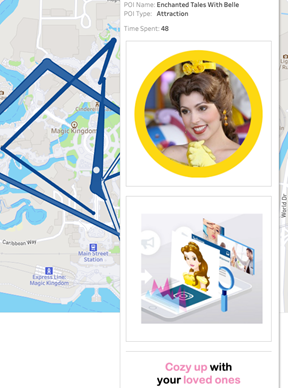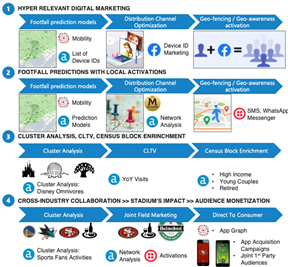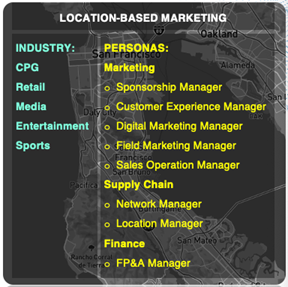“Everyone […] hoping to capitalize on a wide-open summer and the marketing dream of a post-pandemic Roaring Twenties economic boom have begun pouring money into advertising” […]
—Ben Smith, In the Roaring Twenties, Ads Make a Comeback, The New York Times
These words reflect the general sentiment of marketing managers as they grapple with the compound effect of online and offline experiences following the COVID-19 pandemic.
As we return to some semblance of normalcy, according to Chris Weil, chairman and chief executive, experiential advertising agency Momentum, “the second half of this year, there is just going to be an onslaught of physical events.”
In response, marketers are turning to hyper-targeted marketing solutions to bridge the gap between the online and offline world and provide a personalized experience on a whole new level.
How it Works
Mobile advertising is any form of advertising that appears on mobile devices such as smartphones or tablets. Those ads that seem to follow you everywhere you go? That’s the concept at work here. To accomplish this, mobile advertising relies on advertising IDs shared within a business partner’s ecosystem. The Interactive Advertising Bureau (IAB), defines an advertising ID as a user-resettable ID assigned by the device or operating environment for advertising purposes.
Anonymized mobile advertising IDs are used to understand:
- Mobile app activities
- An individual’s movement within a given territory
Advertising IDs enable marketers to run sophisticated segmentation analysis that allows for improved tracking capabilities, attribution, and the monetization of future campaigns.
For example, a NFL team segmented their consumer acquisition list mapped to movement and dwell time to country clubs, private airports, and high-end hotels for a more fine-tuned sales offering.
Many advertising and social media platforms offer the ability to ingest custom audiences based on advertising IDs. Such campaigns can be utilized for a wide range of calls to action, from the acquisition of first-party data (signing up for email lists or mobile app downloads) to purchasing conversions.
The successful conversions can then be used to build look-alike models to extend the audience reach, leveraging the rich information of social media and advertising platforms.
Finally, first-party acquisitions open the door to geofencing marketing activities like the successful Burger King Whopper Detour, a campaign that resulted in millions of downloads of the Burger King app and over half a million coupon redemptions.
A Suggested New Approach to Personalization
Deemed “the year of hyper-relevant messages”, 2021 reigns supreme in the eternal battle to gain consumers attention.
Gleaning information on where people spend their time on apps and in the physical world provides a wealth of opportunities for personalized messages.
Often, traditional advertising agencies go through months-long cycles to identify an audience and build the right creative messaging and visuals.
We believe that building and managing the atomic elements of creative work will allow individuals to capture dynamic audiences in the physical space and deliver fast activations contextual to real-life events. A prime example of this is Oreo’s real-time Twitter response to a blackout during Super Bowl XLVII, “dunk in the dark.”
Creative can be tagged to relevant places or categories of places to build visuals relevant to experiences in the physical world. In mobile advertising, the text is a critical component of the creative copy, much more than sound. Behavioral science can help optimize and select the right set of text copies.
In Nudge Me Right, Eyal Peer et al., describes how to pre-design a finite set of messages, or personalized nudges (simple and effective interventions that alter the architecture in which people make choices in order to help them make decisions that could benefit themselves or society) based on an individual’s decision-making style.
Just like music is composed with only seven notes or like painting relies on three primary colors, there is no need to craft an infinite number of messages. The anchor to a limited number of messages may be the “state of mind” that a place may evoke when recalled by creative copy or visuals.
In his book, “Marketing to Mindstates”, Will Leach provides a great framework for how nine human motivations (achievement, autonomy, belonging, competence, empowerment, engagement, esteem, nurturance, security) can be primed to trigger a desired mindstate, such as esteem for Tiffany jewelry (who doesn’t love that little blue box!) or a sense of belonging for riders in Harley-Davidson clubs.
Location, Location
Consumers are receptive to location-based ads, with 80% of consumers indicating they want location-based alerts and three-quarters of consumers completing an action after receiving a message when they approach a physical location. It’s no wonder that businesses are embracing this latest trend in location-based marketing.

Pre-tagging digital assets and text to locations and experiences allow running activations with incredible speed and scale if supported by the right technology and analytics.
Out-of-Home Advertising
Mobile data supports the analytics to both plan and close the loop on out-of-home advertising.
Footfall prediction, for example, along with the type of audiences in a particular area allows to better plan and sell digital advertising space.
Mobile data can also support strong marketing attribution models as dwell times and directionality can be captured around digital billboards, providing similar, if not stronger, attribution models as display ads in the digital world.

Mobile Tracking Restrictions
Outside the walled gardens (Facebook, Google, Amazon) the advertising industry has made consistent efforts to make the exchange of value with consumers explicit — content in lieu of attention for advertising.
The situation has led to some malpractice and most notably, public skepticism of advertising (how do they know what I am thinking?) Recently, mobile advertising IDs are being curtailed.
The iOS 14.5 update includes a new privacy framework, AppTrackingTransparency (ATT), that requires all apps to obtain users’ permission before tracking their data. Individuals will be presented with a pop-up screen where they can either grant apps permission or opt out of all tracking.
Based on polls conducted by Apple, only 20-40% of consumers plan to opt-in to app data collection.
Nevertheless, we still see mobile data playing a significant role in building dynamic audiences and highly relevant messages, without discounting the ability to transform an otherwise anonymous visitor into a precious first-party audience.

Shared Audiences as a Co-Marketing Opportunity
As people move about in the physical world, we envision audiences that can be shared across multiple organizations and industries. Imagine the possibilities of uncovering local and national sponsorship opportunities between sports teams and retail/CPG entities (such as restaurants or beverage companies or clothing companies).
Cloud and common analytics platforms can unlock these cross-collaboration opportunities.

Last but not least, local governments, as they develop the smart-city concept, can leverage mobility and IoT data to offer digital services in collaboration with private corporations.
Watch This Next.
See how you can deliver customer insights and digital marketing solutions at scale with Alteryx and Snowflake.